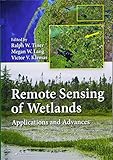Remote sensing of wetlands: applications and advances / edited by Ralph W. Tiner, Megan W. Lang, Victor V. Klemas
Tiner, Ralph W [editor] | Lang, Megan W [editora] | Klemas, Victor V [editor].
Tipo de material: Libro
impreso(a)
Editor: Boca Raton, Florida, United States: CRC Press Taylor & Francis Group, c2015Descripción: xvii, 555 páginas : fotografías, ilustraciones, mapas ; 26 centímetros.ISBN: 1482237350; 9781482237351.Tema(s): Humedales
Libro
impreso(a)
Editor: Boca Raton, Florida, United States: CRC Press Taylor & Francis Group, c2015Descripción: xvii, 555 páginas : fotografías, ilustraciones, mapas ; 26 centímetros.ISBN: 1482237350; 9781482237351.Tema(s): Humedales| Tipo de ítem | Biblioteca actual | Colección | Signatura | Estado | Fecha de vencimiento | Código de barras |
|---|---|---|---|---|---|---|
| Libros |
Biblioteca Campeche
Texto en la configuración de la biblioteca Campeche |
Acervo General | 574.52632 R45 | Disponible | ECO040007090 |
Incluye bibliografía
Preface.. Editors.. Contributors.. Acronyms.. Section I. Introduction To the Use of Remote Sensing for Wetland Mapping.. Chapter 1. Wetlands: An Overview.. Chapter 2. Classification of Wetland Types for Mapping and Large-Scale Inventories.. Chapter 3. Introduction to Wetland Mapping and Its Challenges.. Chapter 4. Early Applications of Remote Sensing for Mapping Wetlands.. Chapter 5. Advances in Remotely Sensed Data and Techniques for Wetland Mapping and Monitoring.. Section II. Summaries of Remote Sensing Technologies and Their Application for Mapping Wetlands.. Chapter 6. Mapping and Monitoring Surface Water and Wetlands with Synthetic Aperture Radar.. Chapter 7. Wetland InSAR: A Review of the Technique and Applications.. Chapter 8. Radar and Optical Image Fusion and Mapping of Wetland Resources.. Chapter 9. Theory and Applications of Object-Based Image Analysis and Emerging Methods in Wetland Mapping.. Chapter 10. Unmanned Aerial Systems and Structure from Motion Revolutionize Wetlands Mapping.. Section III. Applications of Remote Sensing For Mapping Specific Wetland Habitats.. Chapter 11. Remote Sensing of Submerged Aquatic Vegetation and Coral Reefs.. Chapter 12. Remote Sensing of Mangroves.. Chapter 13. Tidal Marsh Classification Approaches and Future Marsh Migration Mapping Methods for Long Island Sound, Connecticut and New York.. Chapter 14. Using Moderate-Resolution Satellite Sensors for Monitoring the Biophysical Parameters and Phenology of Tidal Marshes.. Chapter 15. Great Lakes Coastal Wetland Mapping.. Chapter 16. Mapping Wetlands and Surface Water in the Prairie Pothole Region of North America.. Chapter 17. Mapping the State and Dynamics of Boreal Wetlands Using Synthetic Aperture Radar.. Chapter 18. Fusion of Multispectral Imagery and LiDAR Digital Terrain Derivatives for Ecosystem Mapping and Morphological Characterization of a Northern Peatland Complex
Chapter 19. Airborne LiDAR-Based Wetland and Permafrost-Feature Mapping on an Arctic Coastal Plain, North Slope, Alaska.. Chapter 20. Hybrid Mapping of Pantropical Wetlands from Optical Satellite Images, Hydrology, and Geomorphology.. Chapter 21. Capturing the Dynamics of Amazonian Wetlands Using Synthetic Aperture Radar: Lessons Learned and Future Directions.. Chapter 22. Mapping China's Wetlands and Recent Changes with Remotely Sensed Data.. Chapter 23. Mapping Invasive Wetland Plants.. Chapter 24. Multisatellite Remote Sensing of Global Wetland Extent and Dynamics.. Section IV. Promising Developments and Future Challenges.. Chapter 25. Promising Developments and Future Challenges for Remote Sensing of Wetlands
Utilizing top scientists in the wetland classification and mapping field, Remote Sensing of Wetlands: Applications and Advances covers the rapidly changing landscape of wetlands and describes the latest advances in remote sensing that have taken place over the past 30 years for use in mapping wetlands. Factoring in the impact of climate change, as well as a growing demand on wetlands for agriculture, aquaculture, forestry, and development, this text considers the challenges that wetlands pose for remote sensing and provides a thorough introduction on the use of remotely sensed data for wetland detection. Taking advantage of the experiences of more than 50 contributing authors, the book describes a variety of techniques for mapping and classifying wetlands in a multitude of environments ranging from tropical to arctic wetlands including coral reefs and submerged aquatic vegetation. The authors discuss the advantages and disadvantages of using different remote sensing techniques for wetland detection under varied conditions and circumstances. They also analyze commonly available data, reveal cost-effective methods, and offer useful insights into future trends. Comprised of 25 chapters, this text: • Presents methods readily applicable to real-world challenges. • Contains advanced, new techniques communicated by top scientists in the field. • Covers a diverse set of landscapes and technologies. • Reviews many of the datasets and techniques that are responsible for advances in this discipline and their application for wetland mapping. • Addresses the need to effectively manage this environmental resource. Remote Sensing of Wetlands: Applications and Advances uses a variety of contributors, touching on pertinent topics, to help you gain a greater understanding of the latest technologies, strengths, and limitations surrounding this emerging field. eng
